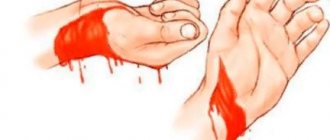Why does the vein in my leg burn?
It is difficult to answer the question why a vein in the leg burns if you do not know the person’s anamnesis (life history and illness). Therefore, before the doctor begins instrumental studies, he is sure to ask whether there were any prerequisites for the development of such a complaint as a burning vein in the leg.
The following may be considered prerequisites:
- Varicose veins in close relatives;
- Complaints of pain, heaviness and fatigue in the legs, which manifest themselves especially clearly in the evening and after static load;
- Green veins on legs;
- History of vein blockage;
- Spider veins on the skin of the legs.
If a person has the above symptoms, then it is highly likely that he suffers from varicose veins of the lower extremities. If there is a symptom such as a burning vein in the leg, the doctor may assume the development of complications of varicose veins: thrombophlebitis and deep vessel thrombosis.
These dangerous conditions develop when a blood clot forms in the lumen of blood vessels. The difference between them is where exactly the thrombus is localized: if in the superficial venous system it is thrombophlebitis, in the deep venous system it is thrombosis.
Varicose veins of the pelvis - symptoms and treatment
Pelvic varicose veins (PVD) is a disease characterized by dilation of the ovarian veins and intrapelvic venous plexuses [3].
The ovarian vein is a paired vessel that carries venous blood from the ovaries. The right ovarian vein drains into the inferior vena cava, which directly opens into the right atrium. Blood from the left ovarian vein is sent first to the left renal vein and then to the inferior vena cava.
The intrapelvic venous plexuses include a set of veins of various calibers that envelop certain organs and are repeatedly connected to each other. These are the pampiniform plexus of the ovary, uterovaginal, vesical, presacral and rectal plexuses, which also interconnect and drain venous blood from the corresponding organs. Blood from the pampiniform plexus flows mainly into the ovarian veins, from other plexuses - into the internal iliac veins, from where through the common iliac veins it enters the inferior vena cava.
The diversity of views on the development of varicose veins of the pelvis also determines the presence of significant “scatter” in the terminology of this disease. In the domestic literature, the following names are used to denote the disease: pelvic varicose veins, pelvic varicose veins, pelvic varicose veins, pelvic venous congestion syndrome, varicose ovarian veins, left ovarian vein syndrome, pelvic organs overflow syndrome. In the English-language literature, the following terms are used: pelvic congestion syndrome (pelvic venous congestion syndrome), pelvic varicies (pelvic varicose veins), pelvic venous incompetence (pelvic venous insufficiency), pelvic venous disorders (pelvic venous pathology), Iliac vein insufficiency syndrome (iliac vein insufficiency syndrome). veins), pelvic varicocele (pelvic varicocele), pelvic venous stasis (pelvic venous stasis) [1][2].
The disease occurs in all biological periods of women’s lives and does not tend to decrease [4]. VBT is observed in 6-15% of women of reproductive age [5].
This pathology is traditionally associated with the female gender, and therefore it is often called pelvic varicose veins in women. However, recently this concept has begun to extend to males. In this case, the gonadal vein is also damaged, which in men is represented by the testicular vein [6].
Pelvic varicose veins, better known in English literature as pelvic congestion syndrome, is relatively “young”, since it has only recently been identified. Nevertheless, this is a very relevant and independent form of the disease, and its manifestations are witnessed not only by vascular surgeons, phlebologists and gynecologists, but also by a fairly wide range of doctors of other specialties. That is, patients with VBT are treated by various specialists who find something familiar from the arsenal of complaints of this category of patients.
Due to the lack of knowledge of the disease, the diversity and non-specificity of clinical manifestations hidden behind the masks of various diseases, patients with VBT are often subject to long-term and not always adequate observation by urologists, proctologists, vertebroneurologists, nephrologists, gastroenterologists, surgeons, orthopedists, endocrinologists and infectious disease specialists [7] . At the same time, long-term and unsuccessful treatment of symptoms, when efforts are aimed not at the cause of the disease, but at combating its destructive consequences, leads patients into a vicious circle, leaving them alone with their disease. The inability to lead a normal lifestyle, constant pain leading to a decrease in physical and social capabilities, conflicts in the family associated with an inferior sex life, suspicions of faking and exaggerating their symptoms worsen the psychosomatic state of sick women, increasing anxiety and irritability. Ultimately, all this becomes the reason for their referral to a psychiatrist or sex therapist, which, unfortunately, only aggravates the disease [8].
Causes of the disease
Pelvic varicose veins are associated with chronic stagnation of venous blood in the pelvis. The conditions for the occurrence of this process arise against the background of various provoking factors that occur over the course of a woman’s life. The main ones are multiple pregnancies and childbirths . The incidence of the disease is directly proportional to the number of pregnancies. Other risk factors:
- age (most often found in active reproductive age - from 21 to 31 years) [48];
- unfavorable working conditions (forced long periods of sitting or standing, heavy physical labor);
- hereditary predisposition: collagenosis (diseases characterized by damage to connective tissue, especially fibers containing collagen) and angiodysplasia (various structural anomalies of arterial, venous, lymphatic vessels);
- conditions and diseases that increase intra-abdominal pressure (chronic respiratory diseases, constipation, strength sports, etc.);
- sexual dysfunction;
- excess body weight;
- hormonal contraception.
In addition, various gynecological pathologies (inflammatory diseases, endometriosis, ovarian tumors, genital prolapse, bending of the broad ligament of the uterus due to uterine retroflexion), menstrual disorders and hormonal imbalances pose a risk for the development of VBT [9][10].
One of the main causes of the disease is a genetic predisposition caused by impaired development of connective tissue, which is the basis of the structure of the venous wall. In this case, the strength of the connective tissue decreases due to a decrease in various types of collagen in its composition or a violation of the ratio between them [11][12].
No less important predisposing factors for the development of VVT are various anomalies in the development of the venous system (venous dysplasia), previous thrombotic lesions of the inferior vena cava system , as well as the so-called venous compression syndromes . These compression syndromes include May-Turner syndrome (compression of the left common iliac vein by the right common iliac artery) and aorto-mesenteric compression syndrome of the left renal vein - Nutcracker syndrome (compression of the left renal vein in the space between the aorta and superior mesenteric artery), in which external compression of venous vessels, preventing the normal outflow of venous blood from the pelvis [13][14][15].
Who should you turn to when a vein in your leg burns?
Thrombophlebitis and deep vein thrombosis require immediate medical attention. Moreover, the sooner qualified assistance is provided, the higher the chance that only conservative therapy will be required. Therefore, if you feel that a vein in your leg is burning and in addition to this, the symptoms described below appear, then immediately consult a phlebologist.
- Redness of the leg, especially pronounced along the location of the vessel;
- Local increase in skin temperature of the leg;
- Sharp or nagging pain in the leg that prevents you from walking independently;
- Severe swelling of the leg.
Angiologists and phlebologists use blood-thinning drugs—anticoagulants and antiplatelet agents—to treat these complications of varicose veins.
A vein burning in the leg: is it dangerous?
In order to determine why the vessel on the leg is burning, a phlebologist needs additional examination. The doctor, after performing Dopplerography of the vessels of the legs (it allows you to evaluate blood flow), confirms or rejects the diagnosis of thrombophlebitis and thrombosis.
If there is a thrombus in the lumen of the vessel, it will be visible on the monitor screen. It is important to determine the exact location of the thrombus. The risk of a blood clot breaking off from the vessel wall and blocking one of the vessels depends on this.
When a blood clot enters the pulmonary artery, pulmonary embolism develops. PE is a potentially life-threatening condition, since when blood circulation in the lungs is blocked, the entire body experiences oxygen starvation.
How to avoid conditions when a vein in the leg burns?
In order to avoid the sensation of a burning vein, you should follow the prevention of varicose veins of the lower extremities, which includes an active lifestyle, giving up bad habits and regular visits to a phlebologist. This is especially important for people at risk:
- For patients in the postoperative period (no matter what kind of operation was performed), it is not necessary to remain in bed for a long time. As soon as your doctor says you can walk, be sure to move. Immobilization leads to poor circulation and increases the risk of developing a blood clot in the veins.
- According to statistics, a huge number of women experience venous thrombosis and even thromboembolism during pregnancy. Pregnant women are advised to walk a lot in the fresh air, eat right and watch the kilograms they gain. It is advisable that your weight during pregnancy does not increase by more than 12 kg.
Do not ignore the appearance of pain and other symptoms of varicose veins. If treatment is started in a timely manner, thrombophlebitis and deep vein thrombosis do not occur.
Causes
Varicose veins of the lower extremities are a disease that develops for various reasons. The following factors play a role in the formation of pathological changes in the inner lining of the venous vessel:
- burdened heredity;
- obesity;
- hormonal imbalances;
- pregnancy;
- wrong lifestyle;
- chronic constipation.
- uncontrolled use of hormonal contraceptives;
- systematic sports activities.
The main reason for the development of varicose veins is changes in the wall and valves of the veins.
With valvular insufficiency of various parts of the venous bed of the lower extremities, a pathological, retrograde (in the opposite direction) blood flow appears. It is the main factor in damage to the microvasculature. In the presence of various risk factors and under the influence of gravity, the pressure in the venous knee of the capillary increases, which reduces the arteriovenular gradient necessary for normal perfusion of the microvasculature (passing blood through the vascular wall). The consequence is first periodic and then constant oxygen starvation of tissues. Patients with varicose veins have severe pain in their legs because the soft tissues do not receive oxygen, swelling occurs, which compresses the nerve fibers.
In the future, with varicose veins, trophic disorders develop. Varicose veins are accompanied by severe pain in the legs at night. With the development of a trophic ulcer, the pain intensifies. Patients are forced to sleep with a pillow under their feet. If inflammation of the soft tissues around the trophic ulcer occurs, the pain becomes unbearable. In some cases, doctors are forced to prescribe opiates to relieve pain.
Make an appointment







